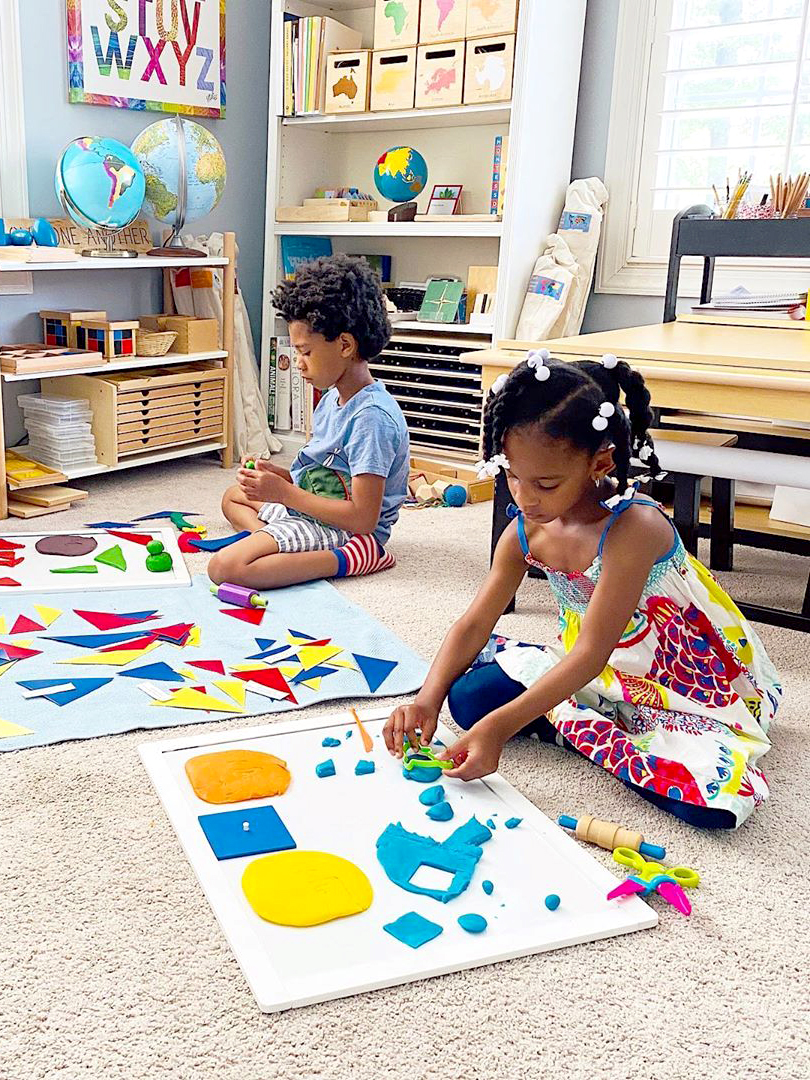We may earn revenue from the products available on this page and participate in affiliate programs.
Markëta Howard didn’t free-fall into homeschooling this spring like many other parents. Four years ago, she fell in love with teaching her son preschool material and decided to keep going. “My husband and I wanted to give our children a loving and vibrant educational environment rather than one where they might be judged because of their race,” she explains.
With her oldest, now 6, entering first grade this fall, and her daughter, 4, starting kindergarten, Howard has developed a method that encourages independence and gives her kids a holistic and objective view of the world: “We teach African-based cultural standards and self-esteem.”
Distance learning for the first time can be daunting, Howard admits, but she believes that every parent already has the support skills within them: “Many of us have homeschooled to some degree, whether we realize it or not,” she says. “It’s built into our jobs as caregivers.” Here, she shares her top tips for setting up a structured work zone and schedule that will benefit little ones and adults alike.
Start With a Cart
If you’re new to homeschooling, Howard recommends setting up an art cart. “We use a simple rolling storage one that holds my kids’ supplies, activity books, and notebooks and pens,” she says. It’s a particularly great solution for small spaces, because it can be easily stored in a closet when not in use and gives kids a place to put away all their materials at the end of the day without having a bulky desk overtaking common areas.
Invest in a Multitasking Desk
Howard swears by the Deluxe Art Center by Guidecraft to keep small children’s workstations organized. “We’ve had ours for four years, and it has served us so well,” she says. The table fits two young kids and is designed with an attached shelving unit to help things stay tidy. It even includes room for an art paper roll, pockets for corralling small items like chalk bits and small crayons, and larger bins for storing bottles of paint and bigger items—that way they learn to keep their workspace clean from day one.

Foster Autonomy
The Montessori method, which Howard practices, encourages parents to set up spaces that promote independence and confidence. “When a child has access to their own art materials and can pour themselves a glass of water or make their own snack, they feel empowered,” she explains. Storing items at a height that’s comfortable for kids helps them develop a strong sense of self. This means lots of low shelving and baskets they can easily reach in the play and learning areas, along with bottom kitchen cupboards being stocked with kid-approved snacks and unbreakable dishware.
Let Them Pitch In
“Everyone in our home is responsible for keeping things tidy, which has greatly contributed to a more simplified routine,” says Howard, who gave her little ones child-size cleaning supplies—think: small brooms and dustpans, cloths for wiping surfaces, easily accessible trays to put away messy art projects, waterproof smocks, and even small spray bottles filled with water for misting plants or surfaces that need to be wiped clean. “Practical life activities are intriguing to young minds who enjoy imitating their parents. I’ve watched my kids become more independent, and I’m amazed at how capable they are,” she adds.

Define the Function of Each Space
Setting physical boundaries between work and play is crucial. “When my son was a preschooler, I noticed he was very interested in learning but needed encouragement to step away from his toys and make the transition to more serious work,” says Howard. She created a dedicated zone free from toys and a separate play area that doesn’t hold any learning materials. That doesn’t mean you need a proper classroom either. “The kitchen table and a shelf for supplies works just fine for us,” she adds. In an open-plan space, defining zones with colored rugs or task lighting can help kids to focus on work, as long as toys are out of sight.
Structure the Day
“Our schedule takes advantage of the time when our kids are most fresh and ready to work, usually in the morning,” says Howard, who sets aside three hours for school in the morning and fills afternoons with creative projects and outdoor play. The mom of two also encourages both independent and collaborative work. She teaches certain subjects, like geography and science (which suit a wider age range) as a group, but also spends one-on-one time on other subjects like math and writing, which are more age-specific.

Schedule Quiet Time
Parents having time to themselves is key to maintaining everyone’s sanity. In the morning, Howard’s kids delve deep into their schoolwork—she gives each of them assignments to complete first thing, which allows her time to disappear into the background for a while. “I’m still present, but not always an active participant,” she explains. After formal lessons, Howard dives into her own work when they’re playing outside, and she instituted a one-hour block of quiet time in the afternoon: “My children know that it means there’s no talking and no loud play. Instead, they can work on a puzzle, draw, or read books.” And that’s the peace everyone needs while stuck at home.
Introducing Domino’s new podcast, Design Time, where we explore spaces with meaning. Each week, join editor-in-chief Jessica Romm Perez along with talented creatives and designers from our community to explore how to create a home that tells your story. Listen now and subscribe for new episodes every Thursday.
